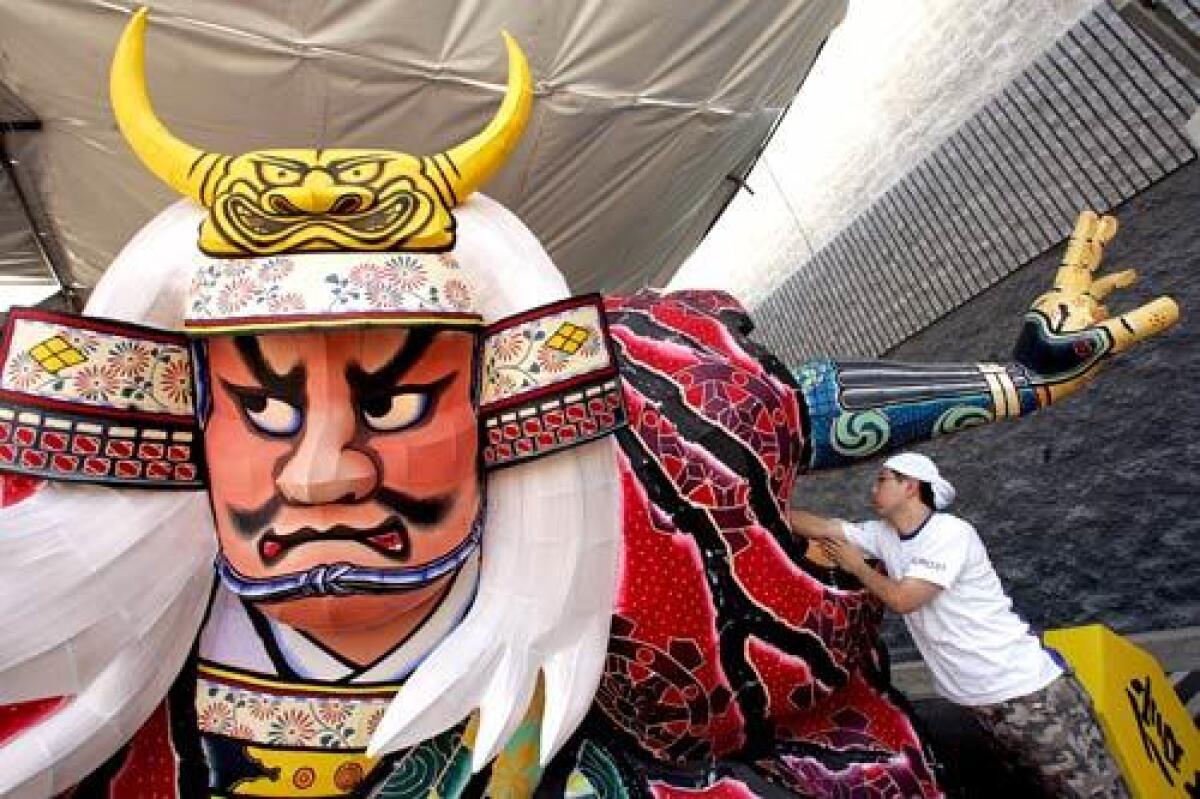Float carries Little Tokyo’s hopes

Long before Disneyland’s nighttime electrical parade, well before the Rose Parade’s dazzling flowered creations, even before America itself was established, the good people of a faraway village in Japan first crafted what would become their nation’s most famous float.
The simple bamboo and paper contraptions created 350 years ago have morphed into colossal visages of fierce samurai illuminated by hundreds of light bulbs. The nebuta floats are featured each August in Japan’s largest festival, a colorful assembly of dancers, musicians and giant paper warriors that annually draws 3.5 million people to the remote northern city of Aomori.
Now, in an effort to revive interest in Little Tokyo, major Japanese corporations have collaborated with Japanese American community organizations to bring the float to the U.S. for the first time as the climax to the annual Nisei Week Grand Parade on Sunday. The $300,000 float project marks the largest collective effort by major Japanese firms to support Little Tokyo in a decade or more, ever since a prolonged recession in Japan led to the closure of many of their Los Angeles offices and drastically curtailed the business they had brought to the historic heart of the Japanese American community.
As the recession has slowly lifted, the Japanese have begun returning to Southern California -- fueling hopes that they will renew their participation in Little Tokyo affairs with projects such as the nebuta festival float. Last year, the number of Japanese business and student visa holders swelled to 60,000 after plunging to 36,000 in 2000, according to the Japanese Consulate in Los Angeles. And the number of Japanese corporations in Southern California grew to 1,194 last year from 954 in 2002, according to a survey by the Japan External Trade Organization.
“What I’m hoping the nebuta project will do is reinvigorate support of Japanese companies in Little Tokyo and show the American public something really traditional from Japan,” said Frances Hashimoto, a board member of the Nisei Week Foundation, which runs the annual Japanese American community festival.
Hashimoto said Japanese corporate support had dwindled from a peak of $100,000 in 1990 to “next to almost nothing” a decade later, as the recession took its toll. But the nebuta float project has drawn support from major Japanese firms, including Kirin Brewery of America, the Miyako Hotel, New Otani Hotel & Garden, Union Bank of California, Yoshinoya, Toyota Motor Sales, Mitsubishi International Corp., Kintetsu International Express, Kajima Corp., All Nippon Airways Co. and KDDI America Inc.
“We wanted to do something for Little Tokyo because this place is so special to Japanese and Japanese Americans,” said Kazuhiro Tsukahara, former president of Kirin Brewery of America in Torrance who first dreamed up the float project.
Tsukahara said he wanted to bring back the bustling excitement he remembered in Little Tokyo during the 1980s, when Japanese corporations flush with cash invested heavily in the area. Back then, Tsukahara said, he and his colleagues would visit Little Tokyo virtually every day for meals, business meetings and entertainment.
Chester M. Ikei, the New Otani Hotel & Garden president who heads the Nisei Week Foundation’s nebuta subcommittee, also was part of the boom years. He was posted to Los Angeles in 1978 to help run the newly opened hotel, part of massive Japanese corporate investment in Little Tokyo that included the development of the Japanese Village Plaza and Weller Court. The area bustled with Japanese tourists and employees, including those from 15 Japanese banks and two major department stores with offices in Little Tokyo, Ikei said.
When the recession hit, many businesses faltered. Both department stores closed. The 15 banks consolidated into a handful. Many Japanese firms downtown either left the U.S. or moved to less expensive areas in the South Bay or Orange County -- including Kirin Brewery, which relocated to Torrance in 2004. The once lively lunchtime and evening crowds dramatically dropped off.
“I would often be asked, ‘Is Little Tokyo dying?’ ” said Hashimoto, who was president of the Little Tokyo Business Assn. at the time. “It’s such a negative question, but it seemed that way.”
When Tsukahara returned for a second tour of duty in Los Angeles in 2004, he was shocked by the decline in Little Tokyo. That’s when he started dreaming up an event to bring the crowds back, Tsukahara said in a phone interview from his current posting in Manila.
Using networks of personal relationships, Tsukahara managed to win support for the project from influential friends with the Miyako Hotel and Union Bank of California, who in turn introduced him to others. They also enlisted the aid of the Japanese Consulate, Japan External Trade Organization, Japan National Tourism Organization and Japan Foundation.
Tsukahara also used his personal and corporate ties in approaching officials in Aomori, a seaside town of 300,000 people on the northernmost tip of Japan’s main island of Honshu. Tsukahara had worked in Aomori for three years, and his firm’s parent company, the Mitsubishi Group, was involved in the town’s business, political and community affairs, including the annual nebuta festival. The town agreed to cooperate, footing one-third of the bill.
The result of the three-year collaboration is now centered in a parking lot at Centenary United Methodist Church on 3rd Street and South Central Avenue in Little Tokyo. There, designer Hiroo Takenami of Aomori and his staff have been working to reassemble the 17-foot-high float, which was completed in Japan and shipped over in four containers.
The float portrays a larger-than-life figure of Shingen Takeda, a famous 16th century feudal lord. It is constructed of wire and paper, painted in vivid colors and dotted with paraffin to bring out the glow of the lightbulbs fastened within. The float will include a Japanese screen with a tiger, Takeda’s symbol, and his battlefield banner inscribed with his military philosophy to be swift as the wind, quiet as a forest, fierce as fire and immovable as a mountain.
Takenami said Aomori’s nebuta float tradition evolved from an ancient Buddhist custom of floating lanterns down a river to carry away ancestral spirits. The lanterns eventually gave way to depictions of samurai to fend off evil spirits and grew in size, particularly after World War II. The word nebuta is derived from the Japanese word for sleep, he said, signifying the need to remain awake and alert.
A hallmark of the nebuta festival is mass participation of crowds, who pour into the street to dance and chant alongside the float. Sunday’s parade will include 300 haneto dancers outfitted in custom festival garb, including summer cotton robes and decorated straw hats.
“This is not a high-class event but a people’s festival for everyone to participate and have fun,” Takenami said. “It’s awesome I can help bring this to Los Angeles.”
--
teresa.watanabe@latimes.com
A ceremony to complete the float assembly and showcase remarks by float designer Takenami is scheduled for today at 11 a.m. at Centenary United Methodist Church, 300 S. Central Ave. The Nisei Week Grand Parade will begin at 6 p.m. Sunday in Little Tokyo. The nebuta float will remain on display the week of Aug. 19 at the Japanese American Cultural & Community Center in Little Tokyo. More information is available at https://www.nebuta-la.org .
More to Read
Start your day right
Sign up for Essential California for news, features and recommendations from the L.A. Times and beyond in your inbox six days a week.
You may occasionally receive promotional content from the Los Angeles Times.







